The Isaiah Davenport House
Introduction
Text-to-speech Audio
The Davenport House, built in 1820, was the first building saved by the Historic Savannah Foundation in 1955. Savannah was a seedy city in the 1950s, and many historic buildings were demolished instead of restored during this time in efforts to improve the city. Savannah writer and artist, Anna Colquitt Hunter, formed a coalition with six of her friends to fight a local funeral parlor from purchasing the Davenport House. Hunter and her friends successfully raised the funds needed to purchase the Davenport House and saved it from demolition. The seven ladies of the Historic Savannah Foundation formed a revolving fund so they could save any historic structure that faced the fate of demolition. Today the Davenport House has been preserved and now serves as a house museum.
Images
The Isaiah Davenport House - home to the Historic Savannah Foundation
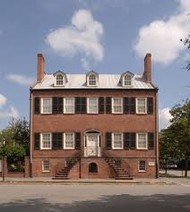
The Isaiah Davenport House- home to the Historic Savannah Foundation
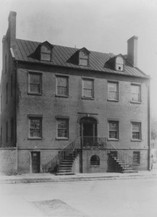
Interior of the Davenport House
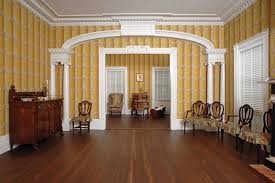

(Left) Anna Colquitt Hunter; (Right) "The Seven Ladies"
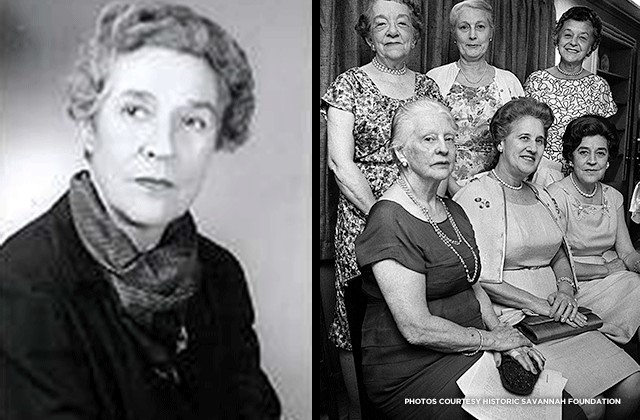
The Davenport House pre-restoration in 1934.
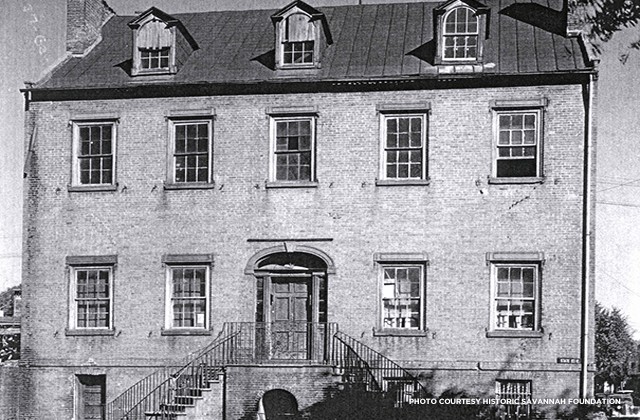
Backstory and Context
Text-to-speech Audio
Isaiah Davenport was a master builder from New England and learned carpentry through an apprenticeship in New Bedford Massachusetts. From 1809 to 1827, Davenport was an extremely successful master builder in the port city of Savannah, Georgia. There were silhouettes of Davenport's family members in his home, however, there are no artifacts describing what he may have looked like, therefore Davenport lives on through his unique architecture. This house served as his home, office, business card, and advertisement, as it was one of the largest and most exquisite homes in Savannah when it was built in 1820. A local architectural historian was quoted as saying, "there was a Davenport house on every block of Savannah."1
Davenport resided in the home until his death in 1827. After his death, Davenport's wife, Sarah, converted the home into a boarding house. Sarah lived in this home until 1840, and when she passed the home was sold to the Baynard family from South Carolina. The Davenport home stayed in the Baynard family until the late 1940s and had become run down from its use as a boarding home. In the 1930s the home was measured by the Historic American Buildings Survey. However, it faced demolition in 1955 due to the trend of destroying old buildings in Savannah, Georgia and converting the space into parking lots or shopping malls in in the 1950s. One woman, Anna Colquitt Hunter, was not going to let that happen to the Davenport House.2
Anna Colquitt Hunter spent the majority of her childhood in Savannah, Georgia and attended Agnes Scott College in Decatur, Georgia where she dropped out of college prior to graduation to get married. Hunter's husband died an unexpected and untimely death, and she was left a widow in her 40s. In order to support herself and her three children, Hunter became a journalist and writer for the Savannah Morning News and the Savannah Evening Press. In 1943 she became a field director for the Red Cross at the age of 51. Hunter was quite the traveler in her 50s as she became the Director of R&R for troops in North Africa and Italy. In 1945 Hunter returned to Savannah and her job writing for the local newspapers, but this time she was a literary and art critic. This position enabled her to publish multiple poems and short stories and become a painter. Hunter's preservation tendencies were born through her art; she painted portraits of historic landmarks in Savannah and plantation culture. She became a true preservationist in 1955 when she galvanized the movement of saving historic structures in Savannah, Georgia, starting with the Davenport House.3
In 1955 Anna Colquitt Hunter was outraged at the destruction of historic structures in Savannah, Georgia. She gathered six women who she knew could make a difference and formed the Historic Savannah Foundation, these ladies are now historically known as, "The Seven Ladies." The HSF raised enough money to purchase the Davenport House before a local funeral parlor could purchase and destroy the historic home, and that was just the beginning of their movement. The Historic Savannah Foundation created a revolving fund that saved many historic structures from being destroyed. Any time they a historic structure went on the market, HSF purchased the building, historically restored it, and placed it back on the market- only to be sold to someone who saw the benefit of living or working in a historic structure. The money made from reselling the structure went back into the fund so that it could be used to purchase more historic structures in need.
The Davenport House was the original headquarters for the Historic Savannah Foundation, now located at 321 E York Street.The first floor of the Davenport House was historically restored and opened to the public in 1963, and as the HSF moved to another building, the second and third floors were renovated and opened to the public as well. The mid-1990s held a re-restoration process for the Davenport House to serve a more authentic experience for museum visitors, complete with accurate wallpaper and furnishings that reflect the inventory taken at the time of Isaiah Davenport’s death in 1827. The Davenport House Museum sees approximately 35,000 visitors annually through its guided tours and education programs.4
Davenport resided in the home until his death in 1827. After his death, Davenport's wife, Sarah, converted the home into a boarding house. Sarah lived in this home until 1840, and when she passed the home was sold to the Baynard family from South Carolina. The Davenport home stayed in the Baynard family until the late 1940s and had become run down from its use as a boarding home. In the 1930s the home was measured by the Historic American Buildings Survey. However, it faced demolition in 1955 due to the trend of destroying old buildings in Savannah, Georgia and converting the space into parking lots or shopping malls in in the 1950s. One woman, Anna Colquitt Hunter, was not going to let that happen to the Davenport House.2
Anna Colquitt Hunter spent the majority of her childhood in Savannah, Georgia and attended Agnes Scott College in Decatur, Georgia where she dropped out of college prior to graduation to get married. Hunter's husband died an unexpected and untimely death, and she was left a widow in her 40s. In order to support herself and her three children, Hunter became a journalist and writer for the Savannah Morning News and the Savannah Evening Press. In 1943 she became a field director for the Red Cross at the age of 51. Hunter was quite the traveler in her 50s as she became the Director of R&R for troops in North Africa and Italy. In 1945 Hunter returned to Savannah and her job writing for the local newspapers, but this time she was a literary and art critic. This position enabled her to publish multiple poems and short stories and become a painter. Hunter's preservation tendencies were born through her art; she painted portraits of historic landmarks in Savannah and plantation culture. She became a true preservationist in 1955 when she galvanized the movement of saving historic structures in Savannah, Georgia, starting with the Davenport House.3
In 1955 Anna Colquitt Hunter was outraged at the destruction of historic structures in Savannah, Georgia. She gathered six women who she knew could make a difference and formed the Historic Savannah Foundation, these ladies are now historically known as, "The Seven Ladies." The HSF raised enough money to purchase the Davenport House before a local funeral parlor could purchase and destroy the historic home, and that was just the beginning of their movement. The Historic Savannah Foundation created a revolving fund that saved many historic structures from being destroyed. Any time they a historic structure went on the market, HSF purchased the building, historically restored it, and placed it back on the market- only to be sold to someone who saw the benefit of living or working in a historic structure. The money made from reselling the structure went back into the fund so that it could be used to purchase more historic structures in need.
The Davenport House was the original headquarters for the Historic Savannah Foundation, now located at 321 E York Street.The first floor of the Davenport House was historically restored and opened to the public in 1963, and as the HSF moved to another building, the second and third floors were renovated and opened to the public as well. The mid-1990s held a re-restoration process for the Davenport House to serve a more authentic experience for museum visitors, complete with accurate wallpaper and furnishings that reflect the inventory taken at the time of Isaiah Davenport’s death in 1827. The Davenport House Museum sees approximately 35,000 visitors annually through its guided tours and education programs.4
Sources
1. Jamie Credle. “Isaiah Davenport: Portrait of a Master Builder (abridged).” YouTube. May 29, 2012. Posted September 13, 2016. https://youtu.be/3CSPpsiD4us.
2. “Our History." Davenport House. 2010. Accessed September 13, 2016. http://www.davenporthousemuseum.org/our-history/our-history.
2. “Our History." Davenport House. 2010. Accessed September 13, 2016. http://www.davenporthousemuseum.org/our-history/our-history.
3. “National Trust for Historic Preservation.” June 2, 2015. Accessed September 13, 2016. https://savingplaces.org/stories/saving-savannah-the-preservation-legacy-of-anna-colquitt-hunter#.V9....
4. “Our Museum." Davenport House. 2010. Accessed September 13, 2016. http://www.davenporthousemuseum.org/our-history.
